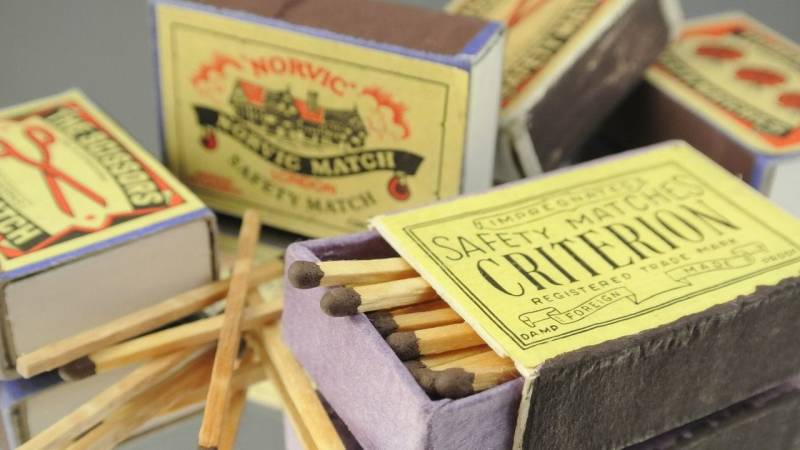
matches
Noun
Meaning
Matches are small sticks with a flammable tip that are used to create fire. In the context of survival, bushcraft, and outdoor activities like camping and hiking, matches are an essential tool for starting fires, which is crucial for warmth, cooking, and signaling for help. Matches are lightweight, compact, and easy to carry, making them a convenient fire-starting option in wilderness settings. They are often stored in waterproof containers to ensure their usability in wet conditions. Having a reliable supply of matches is important for anyone venturing into the great outdoors, as fire is a fundamental element of survival.

Examples
„I love going on camping trips and always make sure to pack matches. They are essential for starting a fire and keeping warm in the wilderness.“
„During my last survival training, my instructor taught me how to use matches to ignite a fire in wet conditions. It was a game-changer and saved me from freezing in the rain.“
„When I go hiking, I always carry a waterproof container filled with matches. You never know when you might need to start a fire for cooking or signaling for help.“
„My friend and I were stranded in the mountains after our GPS died. Luckily, we had matches with us and were able to start a fire to keep warm until help arrived.“
„In a survival situation, matches can be a lifeline. They provide a reliable and quick way to start a fire, which is crucial for cooking, purifying water, and staying safe in the wilderness.“
Origin
The word "matches" originates from the Old French word "mèche," meaning "wick." The concept of using a wick to ignite a flame dates back to ancient times, with the first known use of matches being in China during the Tang Dynasty (618-907 AD). These early matches consisted of sticks made from sulfur and phosphorus, which were ignited by striking them against a rough surface.
The modern match, as we know it today, was invented in the early 19th century by English chemist John Walker. He developed a matchstick coated with a mixture of sulfur, potassium chlorate, and antimony sulfide, which could be ignited by striking it against a rough surface. This invention revolutionized fire-making, making it much easier and more convenient.
Over the years, matches have undergone various improvements and advancements. Safety matches, which only ignite when struck against a specific surface, were introduced in the 19th century to prevent accidental fires. The match heads were also modified to include red phosphorus, which is less toxic than the previous ingredients.
Today, matches are widely used for various purposes, including lighting candles, starting campfires, and igniting stoves. They are an essential tool for survivalists, campers, and outdoor enthusiasts, providing a reliable and portable means of creating fire in the wilderness.
Historical and cultural importance
Matches have a significant historical and cultural relevance as they revolutionized the way we create fire. Before the invention of matches, people had to rely on more primitive methods such as rubbing sticks together or using flint and steel to create sparks. The invention of matches in the 19th century made fire-starting much easier and more accessible.
The cultural impact of matches is evident in various aspects of our daily lives. They have become a symbol of survival and self-reliance, often associated with outdoor activities such as camping, hiking, and survival skills. Matches are also commonly used in religious and cultural ceremonies, where the act of lighting a match represents the ignition of a spiritual or symbolic flame.
Matches have played a crucial role in historical events as well. During World War II, for example, matches were an essential item for soldiers, enabling them to start fires for warmth, cooking, and signaling. Matches have also been used as a means of communication, with hidden messages or codes written on matchsticks during times of war or espionage.
Today, matches continue to be an integral part of our lives, whether for practical purposes or as a nostalgic reminder of simpler times. They serve as a reliable and portable source of fire, making them indispensable for outdoor enthusiasts, survivalists, and those who appreciate the art of bushcraft and wilderness skills.
More information about the term matches
Matches: A Survivalist's Best Friend
When it comes to survival in the wilderness, having the right tools can make all the difference. One such tool that every survivalist should have in their kit is matches. These small, portable fire starters have been a staple in survival gear for centuries, and for good reason. In this article, we will explore the importance of matches in the world of survival and how they can be a survivalist's best friend.
Igniting the Flame
Fire is essential for survival in the wild. It provides warmth, light, and the ability to cook food and purify water. Matches offer a quick and reliable way to ignite a flame, even in challenging conditions. Whether you're facing wet or windy weather, matches can still provide a spark that can save your life.
Unlike other fire-starting methods, such as rubbing sticks together or using a magnifying glass, matches require minimal effort and skill. With a simple strike against a rough surface, the match head ignites, creating a flame that can be used to start a fire. This simplicity makes matches an ideal tool for both beginners and experienced survivalists.
Portability and Convenience
One of the greatest advantages of matches is their portability. They are lightweight and can easily fit into a pocket, backpack, or survival kit. Unlike bulkier fire-starting tools like lighters or flint and steel, matches take up minimal space and can be carried without adding significant weight to your load.
Additionally, matches are convenient to use. They require no additional fuel or maintenance, unlike lighters that need to be refilled or flint and steel that need to be sharpened. Matches are ready to use straight out of the box, making them a reliable and hassle-free fire-starting option.
Types of Matches
There are various types of matches available, each with its own unique features. Standard matches, also known as safety matches, are the most common type. They have a striking surface on the box or container and a chemical tip that ignites when rubbed against it.
Waterproof matches are another popular option for survivalists. These matches are specially designed to withstand wet conditions, making them ideal for rainy or humid environments. They are often coated in a waterproof substance, such as wax or a special chemical, to ensure they can still be ignited even when exposed to moisture.
Stormproof matches take durability to the next level. These matches are designed to withstand strong winds and harsh weather conditions. They are often longer and thicker than standard matches, making them easier to handle and strike in challenging situations.
Conclusion
Matches are a survivalist's best friend when it comes to starting a fire in the wilderness. Their simplicity, portability, and convenience make them an essential tool for any survival kit. Whether you're a seasoned survivalist or just starting your journey into the world of bushcraft, having matches on hand can provide you with the means to create fire and increase your chances of survival in the wild.
Back to overview

